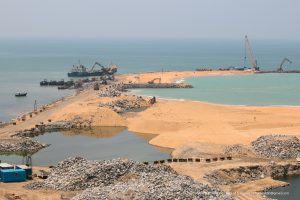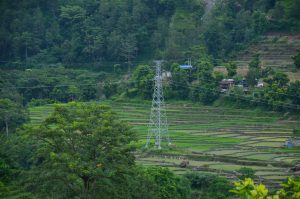While reading the Living Planet Report 2018: Aiming Higher (LPR) recently published by WWF International, I am reminded of the op-ed that I wrote a few days back. The article titled, “Conservation is everybody’s business”, highlighted that conservation is a selfish human need, rather than just an ethical statement. This idea has found a profound yet succinct expression in the LPR that brings to the fore that unbridled anthropogenic activities have led to a decline of 60% of mammals, birds, fish and reptiles between 1970 and 2014. The LPR puts forth the cautionary statement that the conservation of wildlife is an utmost need for survival of human civilisation.
The report marks a clear departure from the trend followed by conservation NGOs putting across an ethical-ecological argument to justify conservation goals. Unfortunately the ecological argument was disconnected from the reality. The approach was: as conscientious human beings, committed to value systems that teach us to respect life on earth, we should think of conservation. This implies that conservation is not considered the core of human economic activities.
The LPR, in an attempt to refute this myth, quotes eminent scientist Bob Watson, “Biodiversity and nature’s contributions to people sound, to many, academic and far removed from our daily lives. Nothing could be further from the truth – they are the bedrock of our food, clean water and energy. They are at the heart not only of our survival, but of our cultures, identities and enjoyment of life. The best available evidence, gathered by the world’s leading experts, points us now to a single conclusion: we must act to halt and reverse the unsustainable use of nature – or risk not only the future we want, but even the lives we currently lead. Fortunately, the evidence also shows that we know how to protect and partially restore our vital natural assets.”
What follows are presentations of critical economic arguments for biological conservation. This requires an interdisciplinary approach and a multidisciplinary team. As an academic and an ecological economist, my first take-away is the richness of the literature surveyed, and the reference list. These include the disparate and traditionally compartmentalised disciplines of ecological sciences, economics and other social sciences.
Reimagining the economics of ecology
In most cases, economists approach the problem of environmental protection and conservation from a developmental point of view. The economic activities (such as production, consumption, procurement, and allocation) are thought to be the core of a system, and the footprints of such activities, in neoclassical economics, have been delineated as “externalities”. The LPR, instead, argues in simple and powerful language that the human society is embedded in the broader ecosystem, and is dependent on it.
Despite being part of the broader ecosystem, economic drivers of consumption and production impede the capacity of the ecosystem to provide ecosystem services. These ecosystem services occur in the form of provisioning (food, raw materials, genetic resources, water, minerals, medicinal resources, energy etc.), regulation (carbon sequestration, climate regulation, pest and disease control etc.), cultural (tourism, religion etc.), and above all, supporting services that are necessary for production of all other ecosystem services (such as nutrient recycling, gene-pool protection, primary production, soil formation). These services are provided by the ecosystem to the human community free of cost, and therefore, their limitation (posed by human interventions on the ecosystem) lowers human well-being.
Typically from this perspective, ecosystems-livelihoods linkages create an important entry point for conservation. As an example, recent research on the Terai Arc Landscape in Uttarakhand, India, conducted by WWF India, finds that the aggregate values of selected seven ecosystem services to be around USD 6 billion in 2015-16. With more than half the population in the region having the earning member of a household earning as little as USD 1.9/day, this ecosystem provides benefits to the tune of USD 6 billion to the human community without asking for anything in return. There cannot be a more powerful call for conservation than appealing to humankind’s selfish economic needs.
The conservation-development trade-off
The LPR builds on long standing discussion about the trade-offs between conservation and development.
The Club of Rome’s The Limits to Growth thesis presented the Malthusian creed of planetary destruction by human greed. The 1992 Earth Summit’s adoption of the Brundtland Commission Report’s definition of “sustainable development”, and opening of the Convention of Biological Diversity (CBD) for signature were other hallmarks of human recognition of the critical ecosystems-livelihoods linkages.
On the academic front, David Pearce and Kerry Turner’s magnum opus Circular Economy in 1989 marked a clear departure from the very reductionist linear growth thinking of “take, make, dispose” to a more holistic paradigm that conceives of the economy as being embedded in the ecosystem.
The Millennium Ecosystem Assessment of 2005 enhanced human understanding of the embedding of human livelihoods and long-term development needs on the ecosystem through a better delineation of ecosystem services. A recent scientific assessment, The Economics of Ecosystems and Biodiversity (TEEB) recognised that these ecosystem services are the “GDP of the poor”, as their income and survival are dependent on the ecosystem. Recent IPBES assessments have also been categorical about nature’s contributions to human society.
LPR should be seen as an extension of all these assessments in its reiterated call for understanding the human community’s suicidal actions by destroying nature. What sets the LPR aside is the lucidity and power with which it makes a public statement with a strong and sound scientific underpinning that is based on a trans-disciplinary knowledge base. More important, it succinctly puts across the phase of the “Great Acceleration” from the 1950s (as we move to the phase of Anthropocene within the geological epoch of Holocene) as being the prime driver and the threat point for conservation thereby further threatening future development. The “Great Acceleration” is the phase over the last 50-70 years when unbridled human actions to blindly promote narrowly defined economic growth led to a phenomenal increase in the demand for energy, land and water “… that is fundamentally changing Earth’s operating system”.
This brings us to the global “degrowth” movement with its prominence in the European Union. Degrowth is gaining popularity as a socio-political-economic movement based on anti-consumerist and anti-capitalist ideas with ecological economics providing its theoretical underpinning. Advocates of degrowth talk of contraction of economies through substantial downscaling of production and consumption, which are the prime drivers of environmental degradation, social-ecological conflicts, and inhibiting the fruits of conservation efforts. Since degrowth is against all forms of “productivism”, it is also thought to be against the existing definitions of sustainable development (Lorek and Fuchs 2013). The critical question that we are facing right now is: can we really afford to reverse the trend of the “Great Acceleration” to satisfy the needs of biodiversity conservation?
The fluid mosaic of freshwater ecosystem
What has indeed drawn my attention in the LPR is the chapter on freshwater. WWF has its inherent strengths in freshwater assessments, and that is clear from this chapter. The best part in this chapter is creating a case for free-flowing rivers. The chapter provides a succinct definition of “free flowing” rivers as four types of connectivity. These are upstream-downstream connectivity (longitudinal connectivity), lateral or width expansions during high flows (lateral connectivity), natural ability to change courses over time without disruptions (temporal connectivity), and ability to draw water from or contribute to underground aquifers and the atmosphere (vertical connectivity). Building infrastructure along, and around rivers often impedes these freedoms, something that policymakers, especially the ones in South Asia, need to take on board.
The LPR describes the effects of such interventions succinctly. “Where river connectivity and flows have already been compromised, actions such as the periodic release of water, floodplain reconnection, or the removal of aging dams can help to restore ecosystem functions. More than 1,500 dams have now been removed from across Europe and the United States.” Lack of understanding of this aspect has resulted in domination of constructionist engineering-centric approaches to harness rivers in large parts of the developing world and have only killed freshwater ecosystems. In an earlier article in thethirdpole.net Jayanta Bandyopadhyay talked of the WEBS (Water-Energy-Biodiversity-Sediment) perspective on river basins for developing a holistic discourse of river basin governance entailing the social, political, economic, literary, cultural, and other dimensions of rivers and their basins. This is a departure from the existing engineering thinking in large parts of the developing world that treat a river as a channel merely consisting of cubic metres of water flow.
In this context, LPR also brings in the important concern of environmental flows, often defined as the quantity, quality, and timing of the flows required to sustain the basin ecosystem and human livelihoods dependent on the ecosystem. The LPR states, “The Brisbane Declaration and Global Action Agenda on Environmental Flows, published in 2018, is a clarion call to governments and stakeholders to build on previous successes through widespread implementation of environmental flows through legislation and regulation, water management programmes and research, linked by partnership arrangements involving diverse stakeholders.” This also echoes the recent global call of the need for protection of aquatic ecosystems by taking a scientific and holistic approach to “environmental flows”.
Threats
The LPR provides a list of threats from habitat loss and degradation (i.e. land-use change), species over-exploitation, pollution, invasive species and disease, and climate change. If one looks at the drivers of these threats, one will essentially trace them to human economic endeavours in the forms of allocation, procurement, production, distribution, and consumption. The bigger implication of this exercise is that one needs to track a product value-chain in order to manage these threats.
The LPR also views these threats through the lens of the Living Planet Index, and realm- or species-specific indices. This matrix is not only unique for visual presentation perspective, but also helps ecosystem managers and decision-makers set the right priorities for conservation management.
A few points to ponder
As a reader, therefore, I find that the LPR provides an informed framework for global conservation governance on the one hand, and informs the general public about their role in the natural ecosystem, and how disruptions in the working of the ecosystem can pose a threat to life on earth including those of the humans. But no report is completely unblemished.
My first point of departure from what the LPR proposes is with its valuation of ecosystem services. While it adopts the Millennium Ecosystem Assessment definitions, my perspective is that there is a need to clearly state that the supporting services are essentially the umbrella services that support the other three ecosystem services, namely, the provisioning services, regulating services, and cultural services. Juxtaposing all four services together have often led to alleged overestimation. Hence, when the LPR quotes USD 125 trillion/ year as the value of the world’s ecosystem services from Costanza et al (2014), some eyebrows may be raised. This apparently seems to be an overestimate given the juxtaposition of supporting services with the other three services. One also needs to consider the fact that the GWP (Gross World Product or GDP of the world) in 2014 was USD 78.28 trillion. Therefore, the figure cited by LPR exceeds the GWP by more than 50%. This indicates possibilities of double counting, assuming that market-price-based estimation approaches have been followed.
Rather than quoting this figure, the WWF network, which has a host of ecological economists and scientists, can definitely have an estimate of its own of the value of world’s ecosystem services or across the landscapes, where they are working. Being an active member of the Natural Capital Coalition, this will help in creating a replicable framework for the corporate partners as well.
My second point of departure is with the under-representation / no representation of the concerns of the global South or the less developed and developing nations, where the concerns of conservation are embroiled with developmental aspirations. South Asia is a case in point. The report definitely needs a separate statement to deal with the conservation-development dynamics of China and India. The two Himalayan nations are at the crossroads of defining their development trajectories while they face many challenges. The “growth-fetishism” of the two economies has brought about negative impacts on the ecosystem, which has often been ignored in the policy discourse. This has given rise to conflicts and social movements, probably a bit more vociferously in India through civil society voices, though they have hardly had much impact on Indian policymaking. The growth aspirations of these nations will not be reined in the near future (Dong et al 2017). Quite naturally, whereas “de-growth”, as discussed earlier, may be a viable option of the global North, this will be treated as an “imposition” of occidental development philosophy hindering the growth potential of the South Asian nations. A separate set of conservation messaging will be needed in these parts of the world, as compared to the developed world. This is missing in the LPR.
Even the governance of the Himalayan river basins poses great challenges, when it is almost impossible to find a “free-flowing” river, as per the LPR definition. LPR should ideally have considered the challenges of transboundary management of the Ganga-Brahmaputra-Meghna basin, where the challenges occur from various dimensions, namely, political at international and national levels, as well as at economic, social, historical and cultural ones. All of these impede taking up a basin-level approach to water governance.
The fourth missing point is that of mountain ecosystems, which definitely deserve a special mention. Mountains have been fragile ecosystems on which large economies and societies are dependent. The Rio conference in 1992 highlighted the important role played by mountain ecosystems by providing livelihood directly to about 10% of the world’s population. In addition, Agenda 21 (UNCED 1992) stated that about 40% of the world’s population is dependent on the various services provided by mountain ecosystems.
To conclude
These issues cannot take away from what the volume has achieved. Readers of this volume, therefore, will be able to appreciate that conservation governance requires a collaborative approach, which can bring together a host of disciplines with a motley group of specialists from various social and natural sciences. There are also takeaways for scientists. For natural scientists, the volume provides the opportunity to understand and appreciate the social and economic drivers of environmental changes. For social scientists, and especially the economists, the report is yet another call to expand developmental philosophy from a narrow, myopic “growth-fetishism” to a more ecologically informed, socially responsible framework that must always include the cause of biodiversity conservation for sustained human well-being.
![<p>Green sea turtle (Chelonia mydas) with a plastic bag, Moore Reef, Great Barrier Reef, Australia. The bag was removed by the photographer before the turtle had a chance to eat it [image by: Troy Mayne WWF]</p>](https://dialogue.earth/content/uploads/2018/11/Turtle-WWF-300x289.jpg)







